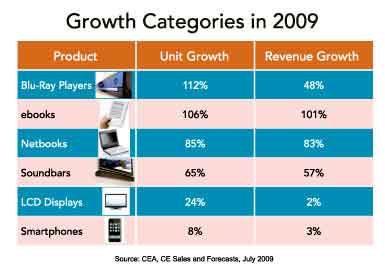Electronics: Recharge Required for a Changing Industry
Once driven by unceasing consumer demand, the electronics industry has been powered down by the recession and the changing habits of buyers and users.
Oct/Nov 09

The Changing Dynamic
Like many industries, electronics was on pace for a respectable 2008 until the bottom fell out in the fourth quarter. According to Dale Ford, senior vice president of iSuppli, an El Segundo, California-based consulting firm, the impact of macroeconomic conditions on the electronics industry is almost unprecedented.
"In the past it's been a factor, but the primary driver of industry cycles was the dynamics of that specific market," says Ford. "PC shipments were dominated more by the introductions of new PC features or new operating systems, or things of that nature. When you went from a multimedia PC to a web-connected PC, that drove the cycle. Those are the types of things that were influenced directly by the players in the PC industry. In this case, the downturn of the PC segment was not driven by anything unique to the PC industry or any particular products or innovation or lack of innovation - it was simply driven by this global macroeconomic environment."
The PC example, Ford says, applies to any number of other industry segments - all of which were unprepared for the phenomenon. "That's why we had such a dramatic impact in the fourth quarter [of 2008], and in the first quarter of this year," he says. "That's why you had companies that had to go into immediate action to cut back production dramatically - to conserve their cash flow, as they had to manage through this very unexpected downturn in the marketplace."
The economic impact on the market occurred on multiple levels. "We see cutbacks in consumer and business pending, price deflation, and composition shifts in core categories," says Chris Ely, senior research analyst for the Consumer Electronics Association (CEA), which reports that the consumer electronics industry, which hit an all-time high industry shipments revenue level of $179 billion in 2008 - a 5.7 percent increase over 2007 - is poised to contract by 7.7 percent in 2009, back to $165 billion. "We feel that consumer demand for technology remains intact," he says, "but there are a lot of different forces impacting market opportunity."
One such force is the maturity of some of the categories, such as flat-screen TVs. Ely said sales have been stronger this year for smaller flat-screen TV models than for the larger ones that have performed better in previous years. His theory is that most people have already bought a bigger flat-screen for their living rooms or primary media rooms, and are now buying smaller ones for bedrooms or other secondary rooms.
MP3 players and digital cameras fall into the same category, according to Ely, as most people who plan on buying themselves one have already done so. "The market opportunity for digital cameras is greatly reduced," he says. "We'll see more as gifts than first-time purchasers."
The Bright Spots
While consumer electronics as a total segment is down, the CEA report points to specific areas that continue to grow.
• Midsize displays. Midsize display shipments are expected to hit about 35 million units, which represents a 14 percent increase, even while displays overall will drop as a category.
• Video games. With shipments expected to hit $23 billion, primarily in software, the CEA sees positive growth for video games. In fact, Ely says the CEA expects growth in software to continue at least through 2013.
• Accessories. Always a consistent performer, even if it doesn't receive a lot of attention, the accessories category is considered a reliable lifeline for the electronics industry even during challenging economic times. "We see the total accessories market slated to generate just less than $8 billion in revenues," says Ely. Of that total, $3 billion consists of wireless phone accessories.
• Smart phones. Smart-phone revenue is expected to grow 3 percent in 2009 - a $21 million portion of the total handset market. Ely predicts smart phones will likely comprise 25 percent of the non-PDA handset market. "Increased demand is sparking some fierce competition among manufacturers and carriers, and that should drag down the pricing for the next year," he says.
• Netbooks. A relative newcomer on the scene, and thus still building off a small base, netbooks are seen by the CEA as doubling this year to 8.4 million units. "We think netbooks are here to stay," says Ely.
• Blu-ray players. While starting from a small base, the CEA expects Blu-ray players to hit six million units, which represents a jump of 112 percent, with revenue increasing 48 percent. Revenues are rising more slowly than overall sales because price decreases are helping to fuel the sales jump. "There's been a learning curve, and I think, for Blu-ray, a lot of people felt you could not play your old DVDs on a Blu-ray player," says Ely. "Now that the word is getting out that, yes, you can, people are feeling more comfortable."
Project Announcements
Jabil Plans Rowan County, North Carolina, Manufacturing Operations
07/21/2025
Rolls-Royce Solutions America Expands Graniteville, South Carolina, Assembly Operations
07/18/2025
ORBCOMM Expands Sterling, Virginia, Operations
07/14/2025
Stratos Solutions Expands Fairfax County, Virginia, Operations
07/09/2025
22nd Century Technologies Expands Fairfax County, Virginia, Headquarters Operations
07/02/2025
Howard Industries Expands Mississippi Manufacturing Operations
07/02/2025
Most Read
-
20th Annual Area Development Gold and Silver Shovel Awards
Q2 2025
-
In Focus: AI Is Changing Incentives Math
Q2 2025
-
Optimizing Your Rail-Served Transportation Network: Strategy Before Steel
Q2 2025
-
How to Choose the Right Site for Your Factory in 2025’s Volatile Landscape
Q2 2025
-
From Silicon to Server: Mapping the Data Center Supply Chain
Q2 2025
-
Tariffs, Talent, and U.S. Expansion
Q3 2025
-
First Person: David Robey, Co-CEO of QTS Data Centers
Q2 2025